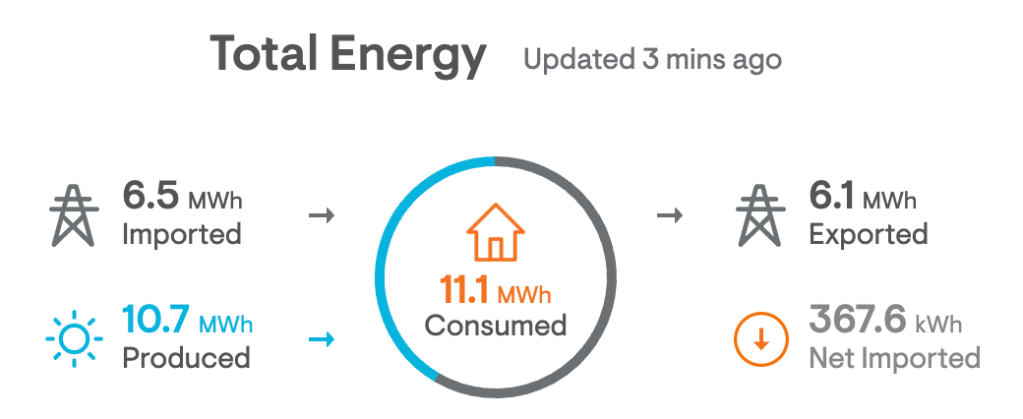
In March of 2023, I had an 8kw solar array installed and I was finally permitted to turn it on starting April 21, 2023.
My pessimistic/optimistic assumption that my buying an expensive solar array was going to be the trigger for technological breakthroughs in solar technology that rendered my panels obsolete wasn’t entirely unfounded. Sure enough, shortly after the install, I started hearing more and more about promising next-generation ‘tandem’ solar cells that will deliver even more power. You’re welcome. Still, those new cells are probably still at least a few years away from broad production, and staying out of the market for another decade didn’t feel like the right choice for me.
The summer of 2023 was a hot one, but my panels achieved one major goal I had in buying them — I stopped cursing the sun on clear summer days.
But how’d I do against the sales pitch from the installer?
Well, not great. The solar installer estimated that I would produce 11.27MWh in my first year. I came in a bit lower than that, producing 10.7MWh, a 5% shortfall. While I never expected the nominally 400W panels to produce at their max for much of the day, they’ve never hit anything close to that (my “8KW” array peaks at 6.4KW).
I also consumed almost 3MWh (38%) more than expected for the year. Of that excess, my Nissan Leaf explains about half (1.5MWh) for the 6700 miles I’ve driven since I installed the panels.
It looks like peak daily production was 48.4KWh on my 9th day of ownership, although I was hitting 40KWh/day for most of the summer. While Austin’s scorching summer days make the panels less efficient, the longer daylight hours and fewer clouds meant that I hit 1.2MWh/month for July and August.
Over the summer months, you can see the big deficit as the air-conditioner works overtime, but over the winter and spring you can see the solar production outpacing consumption (heating is via natural gas):
My lowest consumption day of the year was 6.1KWh (no one was home).
The most fun part of the system is getting negative bills for electricity:
My panels saved me about $1060 ($.0991/KWh) in the first year, making for a pretty long payback period. I’d initially expected the system, post-credits and deductions, to cost $15000, but it turns out that you have to deduct your utility incentives from the cost against which you’re getting a Federal tax credit, so my $2500 Austin Energy incentive reduced my federal credit down from $7470 to a still-respectable $6720.
So, after credits, my Final Installation Cost was $15,680, leaving a payback period of 15 years. Not awesome, but again, the major goal I had in buying solar was that I stopped cursing the sun on clear summer days.
The Enphase monitoring site says that my 10.7MW/h production has saved 7.6 Tons of CO2, or 128 trees.
Thoughts On Batteries 🔋
When I installed my system, I opted not to buy the battery backup system for the house despite the fact that it meant I’d miss out on the federal tax credit available only when solar is first installed. I reasoned that the battery system would itself cost $1000 per year, and in ten years in Austin I have only lost power for a few days. Besides, battery technology is widely expected to continue to improve with every passing year, and hopefully soon using electric cars’ batteries as home backup will become commonplace (even my Leaf’s tiny battery is 40KWh, twice the capacity of a large home system).
Shortly after that decision to forgo the battery, we had our longest-ever power outage, 56 hours, and I wondered whether I’d made a mistake. Ah well.
Before the winter storms of 2024, I bought a 768Wh power station for $475 and predictably (given my luck) the power company managed to keep the power on throughout this year’s storms.
What’s Next? ⚡️
I’d heard great things about induction cooking, so I decided to dip my toes in with a portable cooktop. I like it a lot — it’s convenient and super-fast for boiling water for HelloFresh meals. I’d like to replace my entire stove, but I will likely need an electrical panel upgrade to do that, since my current panel is already at capacity with the car charger.
In the next few years, I’d like to get rid of natural gas entirely (my monthly bill is $26 even if I don’t use any gas). My water heater will age out first and I’ll likely replace it with a hybrid. The big lift will be replacing the heating and air conditioning with a heat pump — bizarrely, these are not yet common in Texas, but they make a lot of sense in this climate and the new federal incentives should help reduce the costs somewhat.
如有侵权请联系:admin#unsafe.sh







